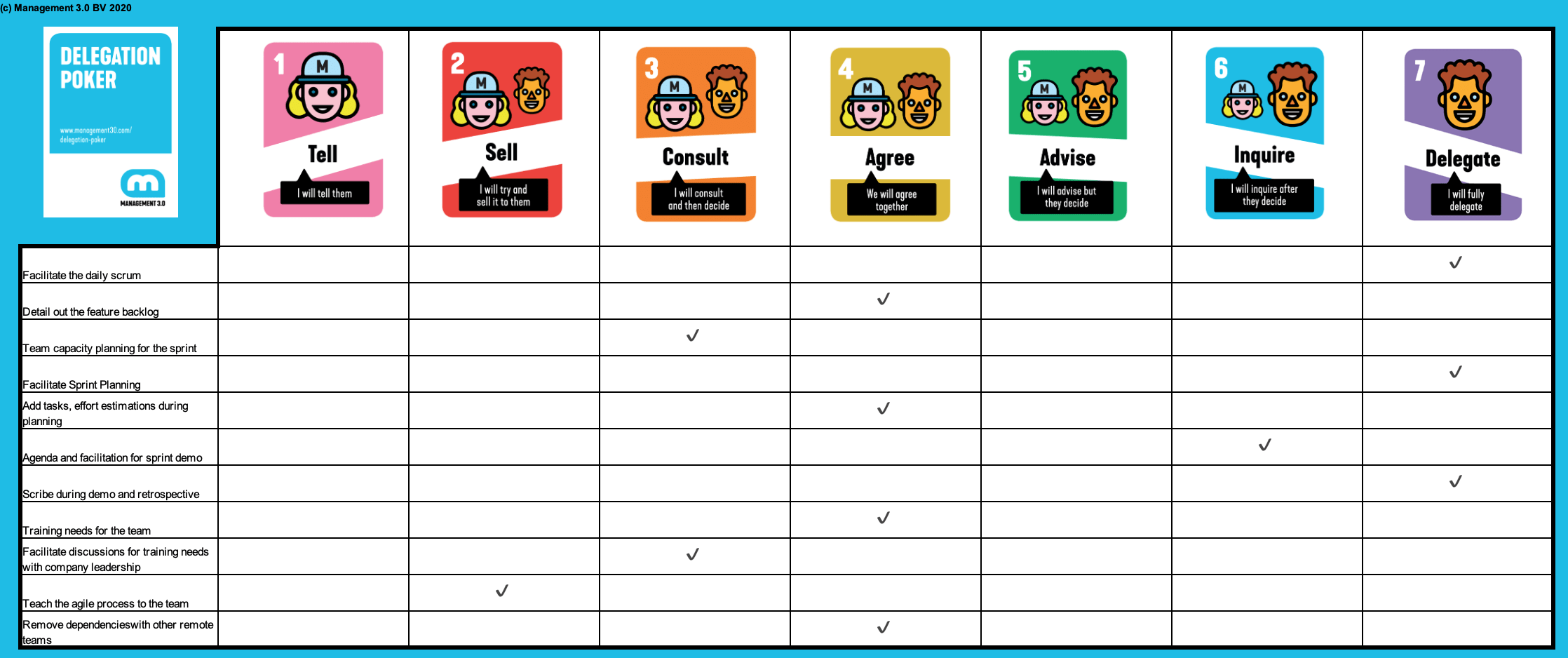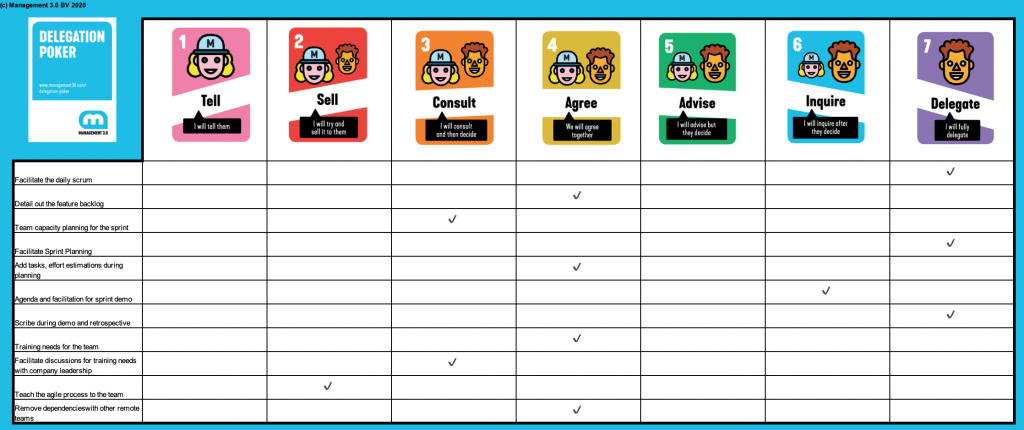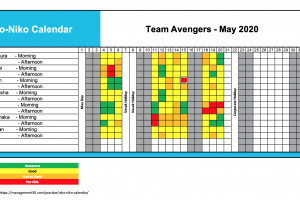
What responsibilities can Scrum Masters let go of?
Delegation Board and Delegation Poker
Human beings are control freaks by nature. We love to keep control and enjoy the certainty that comes along with it. This has sometimes resulted in us ‘biting more than what we can chew’. The number of tasks for which we as individuals are responsible for increase day by day, eating up on our time and finally leaving us stressed and tired. Think of the backlog. It is simply an ordered list of work to be done. Work in a backlog gets done at different speeds (as they are of different complexity) and gets removed from the backlog. But still, new work also keeps on getting added to the backlog, increasing its size day by day. So, the work that we need to do will go out of hand unless we bring in some predictability and control into it.
The above-mentioned problem is common in Agile software projects as well. The scrum masters who play a leadership role in agile delivery teams often fall into this trap of thinking that they need to facilitate, do, be part of, and control everything. They feel that they need to be omnipresent in every situation and manage the situations. The scrum masters today feel that they must lead each and every scrum ceremony, such as; run the daily scrum to ask each and every person for their updates, find out about every technical or non-technical problem the team faces and be part of the solution creating process and so on. But is this sort of control really required?
A key agile principle states to build successful products around self-organized, motivated teams, to empower, and trust them to get the work done. So, can the scrum master pass on some of these responsibilities to the team members and trust them to get those completed? If yes, what can the scrum master let go of? Through this article, I will discuss a management 3.0 activity that I tried with the scrum masters working in a remote environment. I will explain how I played the game of delegation poker with the participants and highlight the decisions we made.
What is Delegation Poker?
Firstly, let us look at what is meant by responsibility. It simply describes who has to put the effort to get a certain task done. For any given task in a project, there can be one or more than one person responsible to get it done. Think about the self-organizing and self-managing teams concept in Agile. During a scrum sprint planning meeting, agile teams identify the features or the tasks and ask ‘which one of you would like to take up this task’. So, simply it means that more than one person can volunteer to take up a technical task in a project. So, why should it not be the case when it comes to scrum master responsibilities as well?
Delegation Poker is an interactive game that can be used to ascertain who is responsible for what task and at what level. It is an ideal alternative to the traditional RACI matrix or the Responsibility Assignment Matrix (RAM). It is the ideal game to play to identify tasks and decisions that can be delegated to others while remaining within controlling guardrails. Delegation is a step by step process and it depends on the situation. So playing the poker game helps identify the grey areas in agreement for a level of delegation.
The 7 levels of delegation as identified by Jurgen Apello of Management3.0 are listed below. Level 1 or ‘Tell’ is more like a dictatorship where the individual takes the decision without consulting anyone which slowly moves towards full delegation in level 7.
Tell – “I will tell them”
No delegation happens here. The entire decision is with one person and only the final decision is passed on to the participants without getting their ideas or opinions. This is a command and control type of an approach with no quarter asked or given assuming that there is just one way of doing something. The tell strategy is useful when dealing with mission-critical tasks or when the decision has a financial or non-financial risk involved.
Sell – “I will try and sell it to them”
The decision-maker will come up with the way forward and try to sell the idea to the team. Here again, the decision is already made but rather than dictating the work to be done he or she tries to convince the team about what must be done.
Consult – “I will consult and then decide”
There is a bit of involvement of the team in the decision-making process here. The decision-maker asks for opinions of the experts who are most accustomed to doing the tasks. However, the final decision is with the decision-maker who makes the final call after considering the information collected.
Agree – “We will agree together”
The two parties come together, discuss what needs to be done in a group setting, and come to a consensus about the way forward. The decision-maker will take accountability for the final decision but the decision is something that the entire group is happy about.
Advise – “I will advise, but they decide”
There is a certain amount of delegation here. The decision-maker makes it a point to advise the team on facts and aspects to consider when exploring ideas. The team ultimately decides what needs to be done but there is a certain amount of dependency on one individual or the leader.
Inquire – “I will inquire after they decide”
The decision making power is transferred to the team at this level of delegation. However, the leader is still inquisitive and request for details about everything that was considered when making the decision.
Delegate – “I will fully delegate and pass it to them”
This is the highest form of delegation here. The entire thinking process, evaluation of options, weighing in of pros and cons, and making the final decision is shifted to the team. This is the level of full autonomy, empowerment, and trust.
Based on the delegation-level selected each participant is allocated points. For example, a person selecting Advice as the delegation-level would get 5 points, and a person selecting Inquire as the level would get 6 points. The person who gets the highest number of points is the person who seems to trust and empower the team the most.
There are several variations of how the next steps of the game are played. For instance, just for the sake of the game, some people may keep on selecting level 7 in order to get the highest number of points. Hence, in some variations of the game, the person selecting the highest and lowest cards must explain why they selected the delegation-level and the voting follows a Delphi mechanism of going into multiple rounds of the game. Alternatively, and the highest minority and lowest minority are not awarded points. This is like a scenario where only 1 person out of a group of ten has indicated a delegation-level of 7 while the others select lesser numbers. I will not spend time explaining these as my objective here is not to explain how to play the game.
What is the Delegation Board?
The delegation board is an extension to the delegation poker game where the participants now mark the agreed delegation level for each decision on a visualization called a delegation board. The 7 delegation levels are represented right across as the 1st row of the board while the key decisions to be explored are indicated as the first column. The facilitator explains the task and the team members play the delegation poker game explained above. The Delphi technique is then used to converge on a delegation value for each task which is then marked on the board. This gives a clear view of the team’s agreement on one single canvas. See the image in the next section of this article to see how the delegation board looks like.
How did I play Delegation Poker and create the Delegation Board?
Below are the steps I followed when playing the Delegation Poker and Delegation Board activity with the 9 Scrum Masters at my organization. Conducting the activity online was a new experience and I had to be innovative in the way I conducted the exercise.
- I created individual lino boards for the 9 scrum masters with 7 separate images of the delegation levels.
- I also created a separate excel sheet to keep track of delegation poker results as the delegation board. This was my master tracking sheet of agreed-upon delegation levels.
- I then added the delegation-level as column headings on the excel sheet.
- I then worked with the Scrum Masters to identify 10 key responsibilities and added them as the 1st column on the delegation board.
- Next, I facilitated the delegation poker session reading out each responsibility one by one.
- The scrum masters clarified doubts and discussed what is explained in each line item.
- Then I counted to 3 and asked all scrum masters to reveal their card on the individual lino board according to the level that they are comfortable in delegating the decision-making process.
- If there was a clear majority and consensus the participants decided to go ahead with the delegation level.
- If there was no majority the scrum masters with the highest and least delegation values explained their stance and we went for another round of voting. This continued until group consensus was achieved.
- I recorded the agreed value for the group against each task on the delegation board.
- I repeated steps 5 to 10 for all the responsibility line items.
The resultant delegation board is shown in the image below.

Learning & Actions
The main learnings and action items from the delegation poker and delegation board exercise carried out with the scrum masters are as listed below.
- A great way to visualize tasks that a typical Scrum Master does
- An opportunity to understand what scrum masters feel about letting go of key decisions they have to make
- Helps to get an idea about what scrum masters are comfortable to delegate and which decisions or tasks they are reluctant to let go of
- The scrum masters realized that they had hung on to certain tasks that they could really delegate to their team members.
- Gives an idea about the amount of trust that the scrum masters have on their team members and the level of comfort in letting go
- Provided a starting point for further discussion on what are the tasks which can be delegated and under what circumstances
- Provides a one-stop visualization of what type of coaching might need to be given to the scrum masters
- In terms of next actions,
- The scrum masters decided to do this as an ongoing activity to check delegation levels for each task on a monthly basis
- The scrum masters decided to delegate activities and decisions according to the group consensus in their own project environments. A decision was made to try it out till the next scrum masters meeting where they intend to discuss their findings and observations.
- The scrum masters decided to identify some more key decisions that they make during an iteration and apply delegation poker to those tasks
- The scrum masters decided that trying out delegation poker in their respective teams is important. One of the scrum masters volunteered to try it out with her team and share the results during the next session.
- I as the Agile Coach identified a few areas to focus on with each scrum master during a one-on-one coaching session just to see whether they would be open to delegate some tasks to their team members.
There are many different ways in which Delegation Poker could be used. Have you used Delegation Poker in your Agile project or coaching engagements? What did you find out? What other activities have you done to identify and promote delegation of tasks? I would like to discuss and share experiences so please do comment below.



